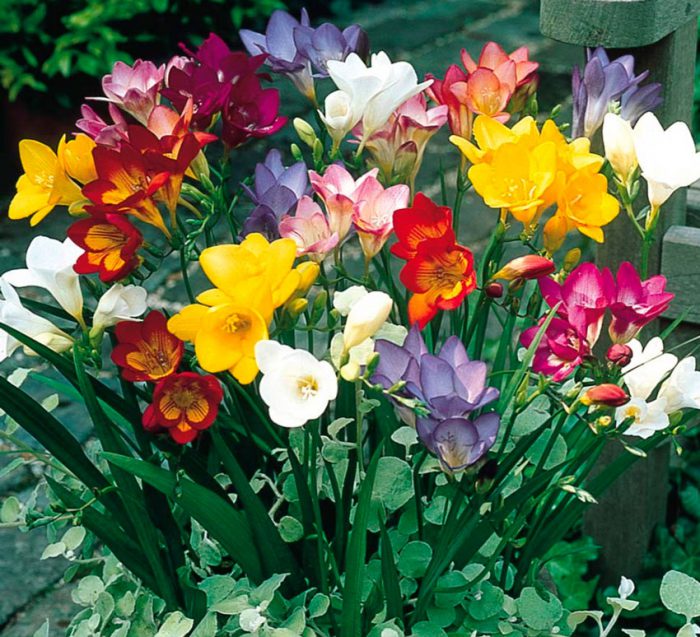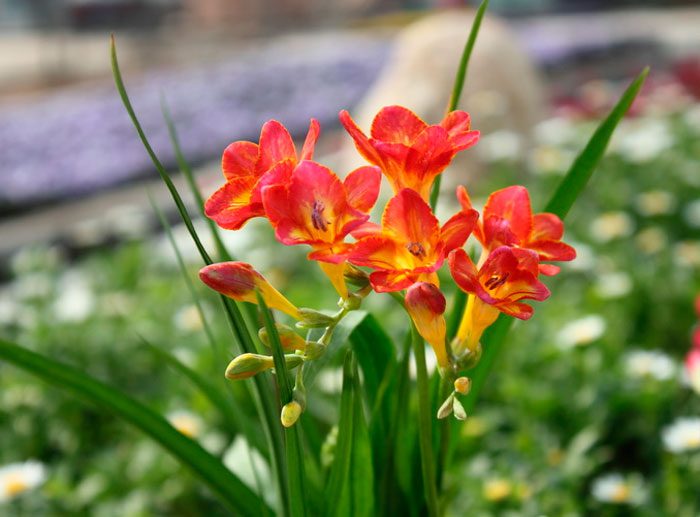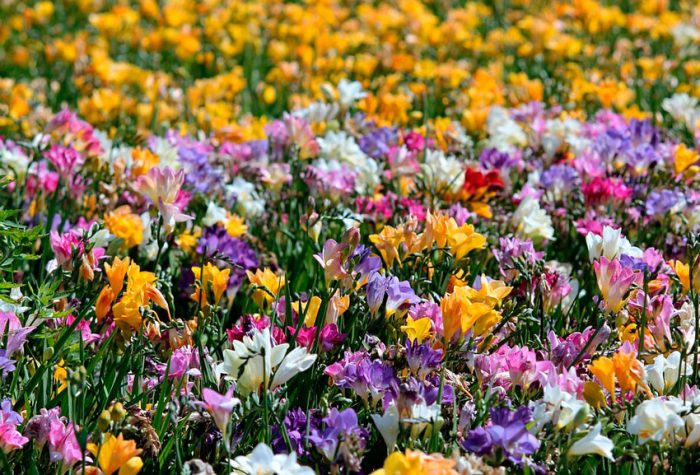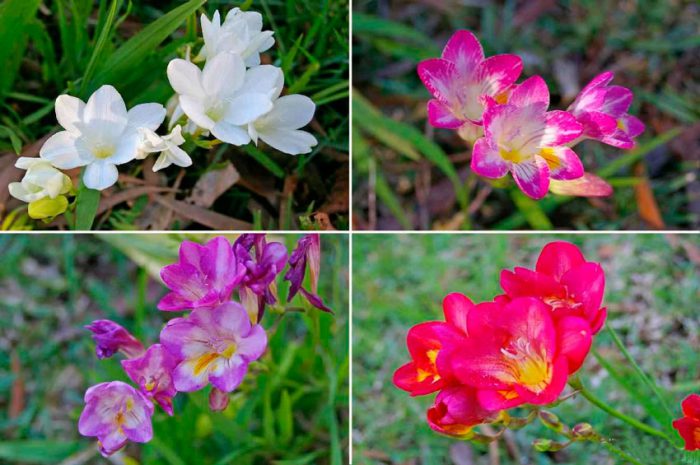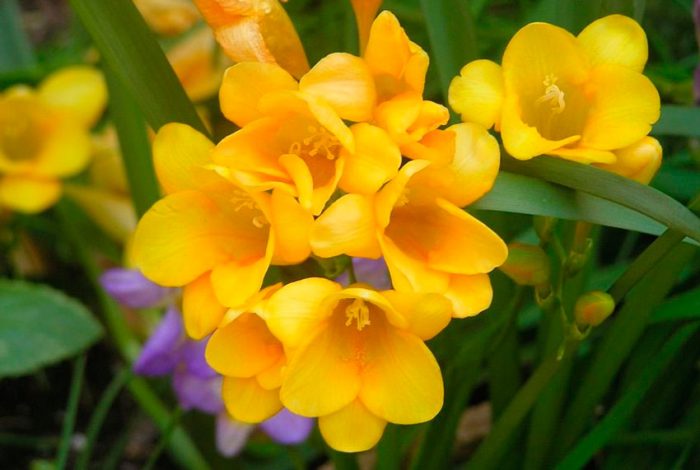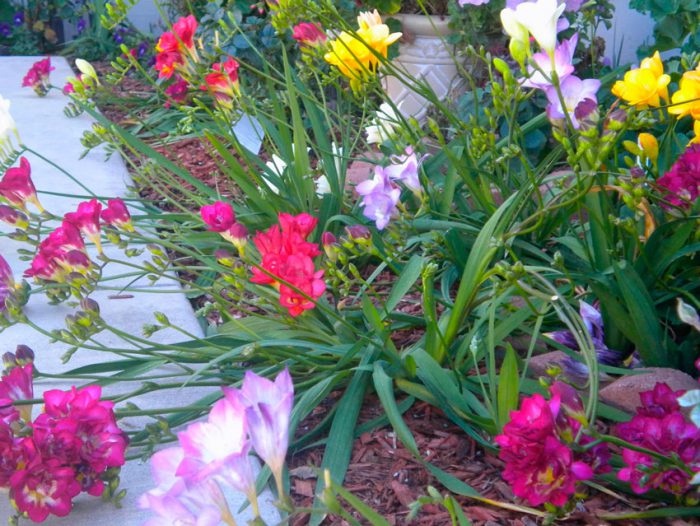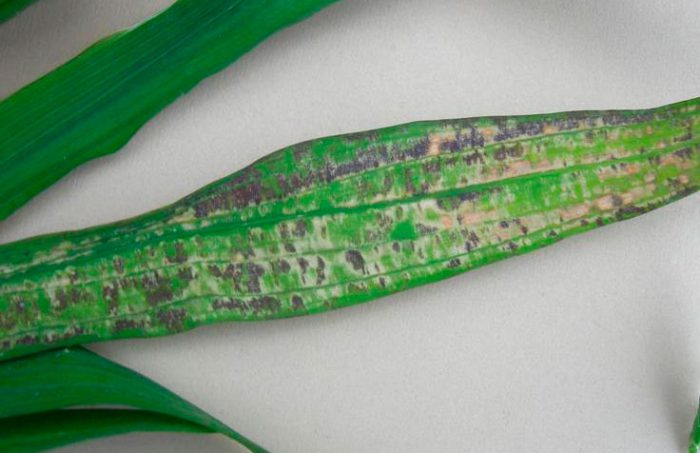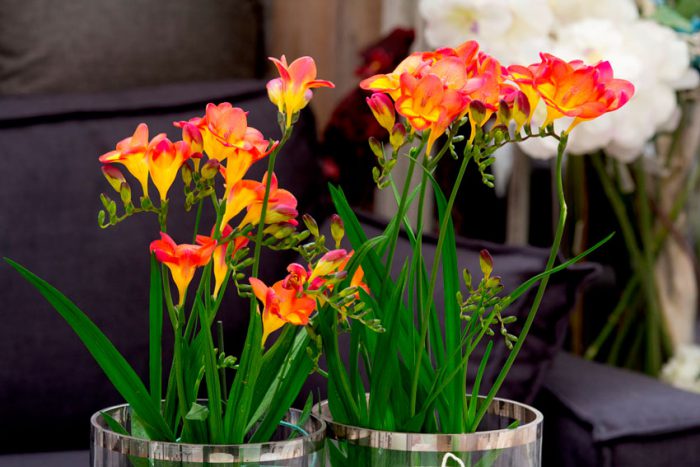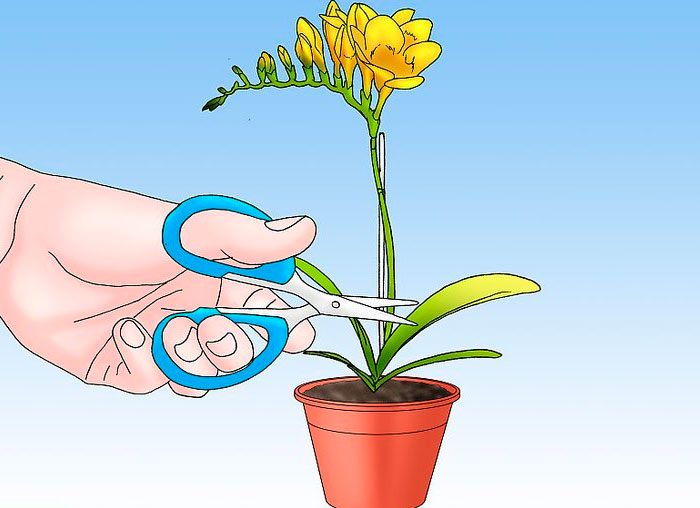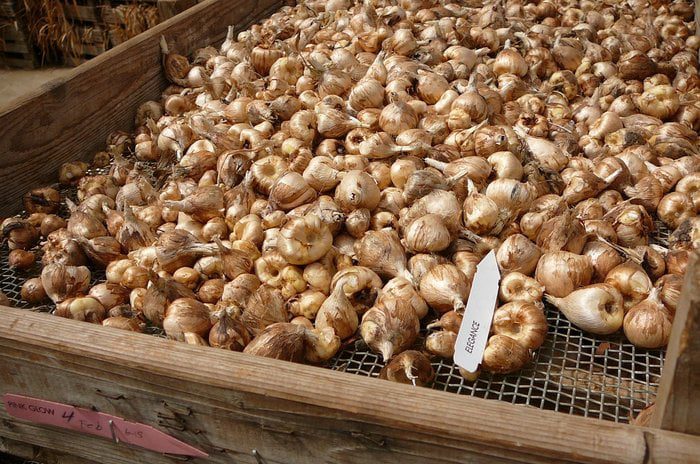A very spectacular bulbous plant Freesia, also called Freesia, is cultivated in the garden and at home. This genus is represented by bulbous herbaceous perennial plants belonging to the Iris family (iris). This genus unites about 20 species. The most popular is hybrid freesia, which was bred almost 100 years ago by crossing several species. This flower comes from South Africa, while it prefers to grow among bushes and on wet shores. This plant was named in honor of the German doctor and botanist F. Vries. This is a very graceful, beautiful and delicate plant, which has a pleasant scent, similar to the scent of lily of the valley, therefore freesia is also called "Cape lily of the valley". At the moment, such a flower is very popular among gardeners as a cut crop.
Content
Freesia features
What are the features of freesia:
- such a delicate flower can decorate any bouquet, it is especially popular with brides;
- for a long time does not lose freshness and does not fade;
- used in the manufacture of luxury perfumery;
- is very popular with landscape designers;
- she can decorate any garden or greenhouse, as well as a window sill;
- the yellow-red variety differs from other varieties in its rapid growth.
The bush of hybrid freesia can reach a height of 100 centimeters, the highly branched stem is bare, thin light brown scales cover the corm. The length of thin sheet plates with a midrib can vary from 15 to 20 centimeters, and the width - from 10 to 15 millimeters. Weak unilateral inflorescences are composed of fragrant flowers, the length of which is from 30 to 50 mm. Flowers can be painted in different colors, for example: red, blue, yellow, pink, white, orange, purple, cream, etc. Often the petals and throat have a contrasting color. The fruit is a capsule.
Types and varieties of freesia with photos and names
Freesia hybrida is the most popular among gardeners. It was created by crossing armstrong freesia (Freesia armstrongii) and refracted or broken freesia (Freesia refracta).Thanks to these species, a large number of different varieties were born.
Freesia armstrongii
The height of the bush can vary from 0.65 to 0.7 m. Panicle inflorescences consist of 3-5 bell-shaped fragrant flowers of pink, scarlet or red. There are yellow spots on the surface of the white tube. Long leaf plates have a xiphoid shape. Flowering is observed in May-June.
The most beautiful variety of this species is Cardinal. The height of the bush is about 0.7 m, non-double flowers are painted red. From one bulb, 3 peduncles grow, reaching a height of 0.35 m, panicle inflorescences consist of 9-11 flowers, while the length of the inflorescences is about 9 centimeters. The dark red flowers have a yellow speck, their pistil is blue, the stamens are yellow, and the anthers are purple.
Freesia hybrid (Freesia hybrida)
This species combines the best qualities of the parent species. A highly branched bush has a height of about 100 centimeters. The composition of racemose inflorescences includes large (5 to 7 centimeters in diameter) fragrant flowers that can be painted in raspberry, purple, yellow or other colors. The flowers are monochromatic and bicolor. Varieties:
- Ballerina... White flowers have a light yellow base, their petals are corrugated. There is a yellow stripe on the surface of the white throat. The inflorescence can include about 12 flowers with a size of 55x65 mm. Peduncle height can vary from 0.25 to 0.3 m. Flowers have a delicate scent.
- Rose Marie... The height of the peduncles is about 20-25 centimeters. The inflorescence contains no more than 7 flowers 45x45 mm in size. Their color is rich crimson, below the flower is white with a crimson line.
- Pimperina... Peduncles in height can reach 15 to 20 centimeters. The inflorescences can contain no more than 7 flowers 60x55 mm in size. The red, slightly crimped petals have a dark red edge. The lower part of the petals is red with yellow strokes. The smell is weak.
Freesia white, or refracted, or broken (Freesia refracta)
This rather miniature plant in height can reach no more than 0.4 m. Thin stems are spreading. Paniculate spike-shaped inflorescence consists of 2-5 white or orange-yellow flowers. Bloom is observed in April. Varieties:
- Freesia Alba (Freesia refracta var. Alba). Snow-white large flowers have a yellow throat with touches of purple.
- Freesia Fragrant (Freesia refracta odorata). The inflorescences consist of 3-7 yellow flowers with an orange speck at the base. Has a pronounced smell of lily of the valley.
All three species described above have varieties with both simple and double flowers. Simple flowers have only 1 row of petals, while double ones have 2 or more. In a specialized store, you can buy a certain variety of freesia or a variety mixture, in this case you will be able to decorate your garden with incredibly beautiful freesia flowers of various shapes and colors.
Growing conditions
To create the most favorable conditions for freesia, it should be grown in a greenhouse or greenhouse, but this method is more suitable for professionals or experienced gardeners. Such a plant, if necessary, can be cultivated all year round. However, in mid-latitudes, it is not able to survive the winter in the soil, therefore, corms are dug up in autumn. Such flowers can be grown at home, while indoor freesia begins to bloom in winter. There are basic rules regarding the growing conditions for all types of this plant:
- Such a flower is very fond of light, while the required duration of daylight hours for it is 12-14 hours. But it should be borne in mind that it does not tolerate the direct rays of the sun, therefore, a small partial shade should be chosen for planting it.
- The plant must be protected from drafts.
- The soil should be loose and well-drained.A soil mixture consisting of leafy, sod and humus soil, as well as peat, which is taken in a ratio of 1: 1: 1: 1, is best suited for growing. It is best if the acidity is low.
- If the variety is small-flowered and narrow-leaved, then it can be planted more compactly, while spreading, broad-leaved ones are planted more freely.
- In order to achieve abundant flowering, the temperature should be controlled. So, until the plant blooms, it should not exceed 22 degrees.
- Cutting flowers can be carried out only when at least 2 flowers bloom in the inflorescence. Flowers that have begun to fade should be cut off in a timely manner, otherwise they will take nutrients from those that have not yet opened.
- Some bushes have weak stems (for example, the broken freesia varieties) and therefore need support.
- The flower needs high humidity. However, when spraying it, it should be borne in mind that moisture should not get on the flowers or buds. It is best to spray at 17-18 hours.
- If the weather is extremely cold or hot, then because of this, the flowers begin to deform and many empty buds grow.
Growing freesia outdoors
Before planting bulbs in open soil, it is recommended to grow them. To do this, in March or April, the scales must be removed from the corms, and then they are placed for 30 minutes in a foundationol solution (0.2%), which will help prevent the development of fungal diseases. After that, they are planted in nutritious loose soil in peat pots, deepening by 50 mm. Then they are transferred to a warm loggia or to a windowsill with good lighting, where the bulbs will stay in the soil before planting. Experienced gardeners sometimes resort to seed propagation of such a plant, but it should be borne in mind that this method is rather laborious and ineffective. The substrate should be moistened and then the seeds are carefully placed on its surface. Sprinkle on top of them with a layer of soil mixture for seeds, the thickness of which should be about 20 mm. Then the container must be covered with glass or foil and removed to a well-lit place. After 3 weeks, the first seedlings should appear. After their height reaches 20–30 mm, the cover must be removed and the seedlings thinned out. Planting in open soil is carried out in mid-May.
Landing in open ground
It is necessary to plant such a plant in open soil in spring, when the threat of frost has passed (after about May 9). The size of the holes should be such that the planting depth is 30–60 mm. A distance of at least 30 mm should be maintained between small onions, and about 50 mm between large ones. Row spacing is approximately 15 centimeters. After planting freesia, the surface of the site is leveled and covered with a layer of mulch (peat or coniferous soil), which will prevent overheating of the soil and the root system of the bushes. In August, each bush will have 1–3 peduncles, while flowering will last until the first days of October.
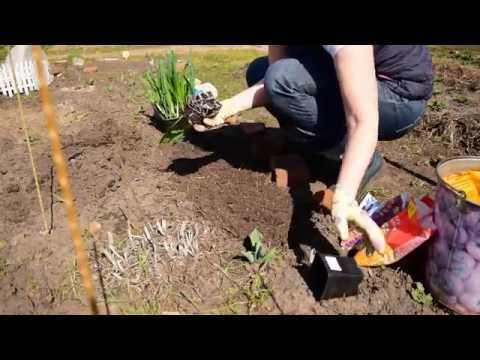

Watch this video on YouTube
Care features
During the growing season, freesia needs timely feeding. For the first time, the plants are fed even after the shoots, for this, a solution of ammonium nitrate is used (2 g of the substance is taken for 1 liter of water). After that, once every 2 weeks, the plants are fed with superphosphate and potassium salt (for 1 liter of water 4 g and 2 g, respectively). Also, when growing in a garden, you should regularly loosen the surface of the site and remove weeds, special attention should be paid to these procedures in the first half of the growing season. When growing freesia in the open field, it needs a certain watering regime. During the period of active growth, and when it will bloom, it is necessary that watering is abundant and systematic, while the soil should be moist all the time.Flowering lasts 3–6 weeks, after which the flowers begin to water less and less each time until they stop. In addition to watering, such plants need systematic spraying of leaf plates and shoots. Watering and spraying is recommended in the evening, but it should be borne in mind that the water must have time to be absorbed before nightfall. In the garden, freesia is grown before the frost begins.
Diseases and pests
The pests and diseases in this plant are the same as in gladioli, namely: aphids, thrips, spider mites, as well as fusarium, scab and various rot. Infected bushes should be dug up and burned. And in order to protect them from disease, it is necessary to disinfect the bulbs in a weak solution of potassium manganese before storing them. The same procedure should be followed before planting them. Also, proper watering will protect freesia from diseases, remember that during its growth and flowering, the earth should not be dry, but at the same time, stagnation of water should not be allowed.
Freesia at home
Landing
In indoor conditions, freesia is cultivated, as a rule, only for the sake of its flowering in winter and spring. Her flowers look great in this dull cold season. For a plant to bloom in January, it must be planted before the fall. To begin with, the onion should be immersed in a solution of azotobacterin for 30 minutes (0.5 g of the substance is taken for 1 bucket of water). If desired, you can treat the corms with a growth-stimulating drug (root or epin). You should take a pot, the diameter of which should be about 15 centimeters. At the bottom of the container, it is necessary to make good drainage, on top of which charcoal is laid out, then a soil mixture is poured into it, consisting of sod and humus earth, as well as sand (2: 1: 1). Do not forget to mix the soil mixture with a small amount of phosphorus-potassium fertilizer. 5 or 6 onions are planted in 1 pot, while they are buried 5-6 centimeters. The container is removed in a well-lit room, in which the air temperature should be within 10-15 degrees, and freesia should not be watered. After the leaf plates appear, the pots with freesias are rearranged to a warm (from 20 to 22 degrees) place and watering begins.
How to care for indoor conditions
Growing such a plant in indoor conditions is easier and easier compared to cultivation in a greenhouse or in the open field. However, first you should learn a few simple rules. In autumn and winter, daylight hours are very short, and such a flower needs light for at least 12 hours a day. Therefore, it is recommended to place the pots on the east or west window, or you can create fluorescent lighting. It should be remembered that the stems of the plant are quite fragile and can be injured under the weight of the flowers, so they need to be tied to the support in time. Watering freesia should be done after the top layer of the substrate dries, for this use rainwater. When the plant blooms, it will need to be watered systematically and abundantly. In the cold season, due to the heating of apartments, the air dries out a lot, in this regard, do not forget to regularly spray the shoots and leaf plates of the plant. To exclude frequent spraying, the plant can be rearranged in a less warm place, for example, on a glazed loggia. Do not forget to fertilize with mineral fertilizers 2 times a month, until the leaf plates completely die off.
Freesia after flowering
Indoor freesia
After the end of the flowering of freesia, all shoots and leaf plates should be cut off from it. The corm should be watered for another 4-6 weeks, in which case new bulbs will appear. Then it is dug up, disinfected with a solution of potassium manganese, dried for several days, placing them in a warm place for this, and stored.
Freesia in the garden
After the end of flowering (as a rule, in the last days of September or the first - in October), corms should be dug up and this should be done before the yellowed leaf plates wilt. It is necessary to cut off the stem with foliage from the corm, remove the earth, roots and old scales from it. Then it is immersed for half an hour in a weak solution of potassium manganese or another fungicide (phytosporin, maxim or foundationazol). Then it is dried for several days in a well-ventilated room at a temperature of 25 to 28 degrees. Then the corms are sorted, and those of them that have begun to rot or have wounds need to be thrown out. After that, they are removed for storage.
Storing freesia bulbs
For storage, corms should be placed in nets and removed to a room with high air humidity (from 70 to 80 percent), where the temperature should be from 20 to 25 degrees. In the event that the humidity in the room is low, then a container filled with water must be installed directly under the mesh with the planting material. Inspection of corms should be carried out at least 1 time in 4 weeks, while corms that have begun to rot or diseased corms should be discarded. 4 weeks before the day of planting, the bulbs must be removed to a cooler place (from 10 to 15 degrees).
There are gardeners who store corms in dry peat. In the event that in your region the winter period is rather mild and not frosty, then the bulbs can not be dug out, but only covered with spruce branches or dried foliage.

